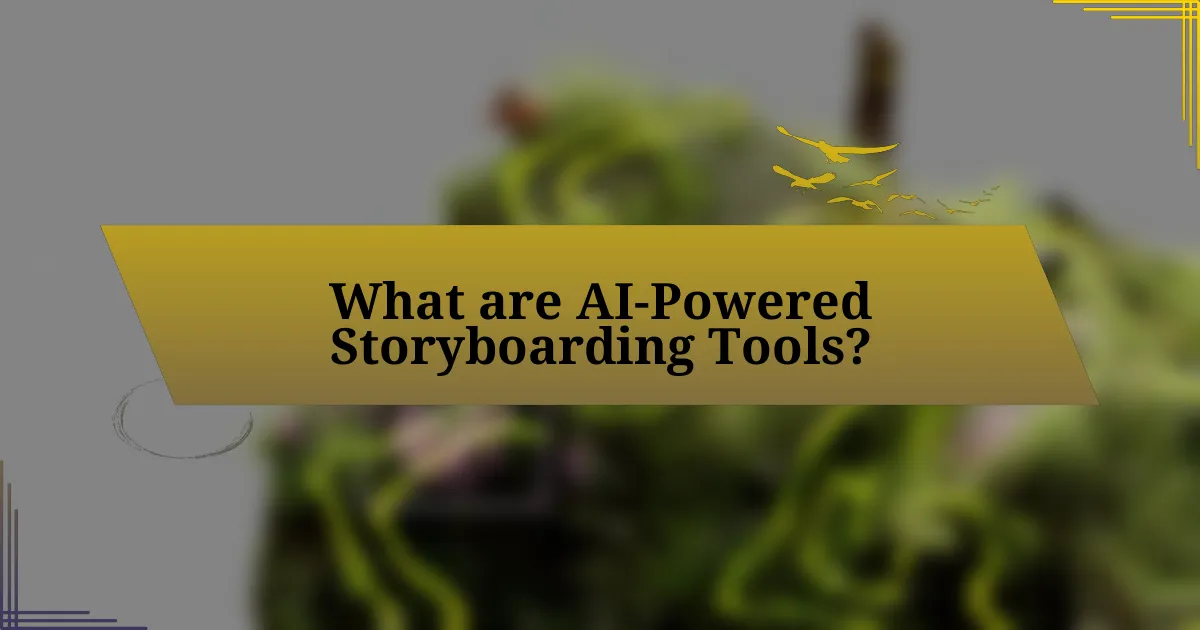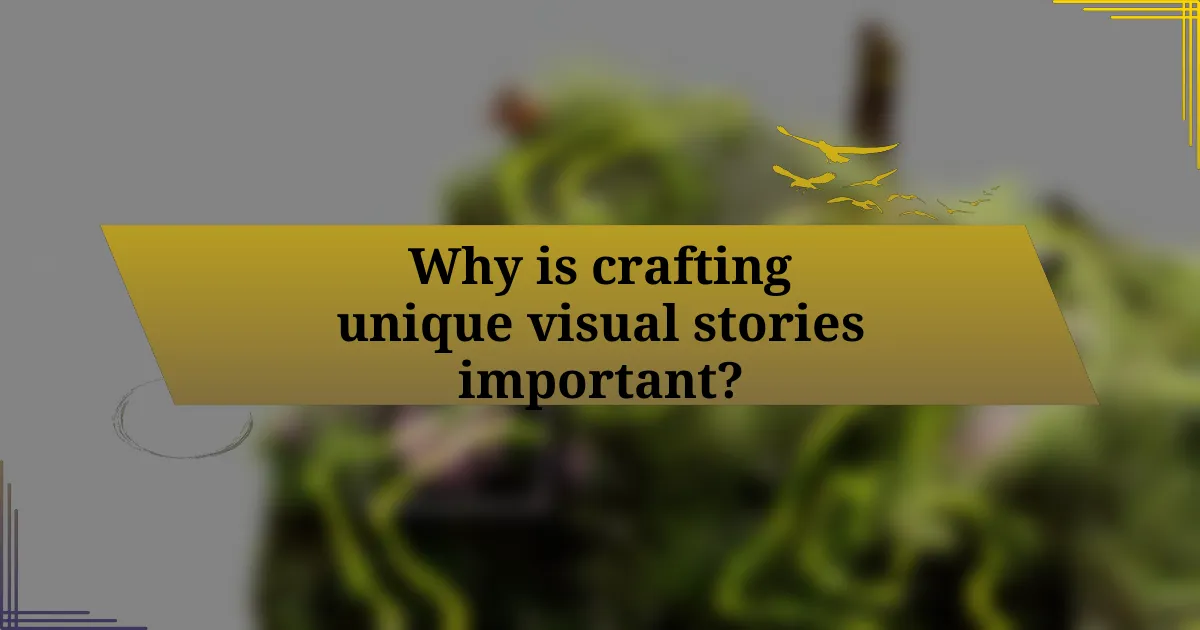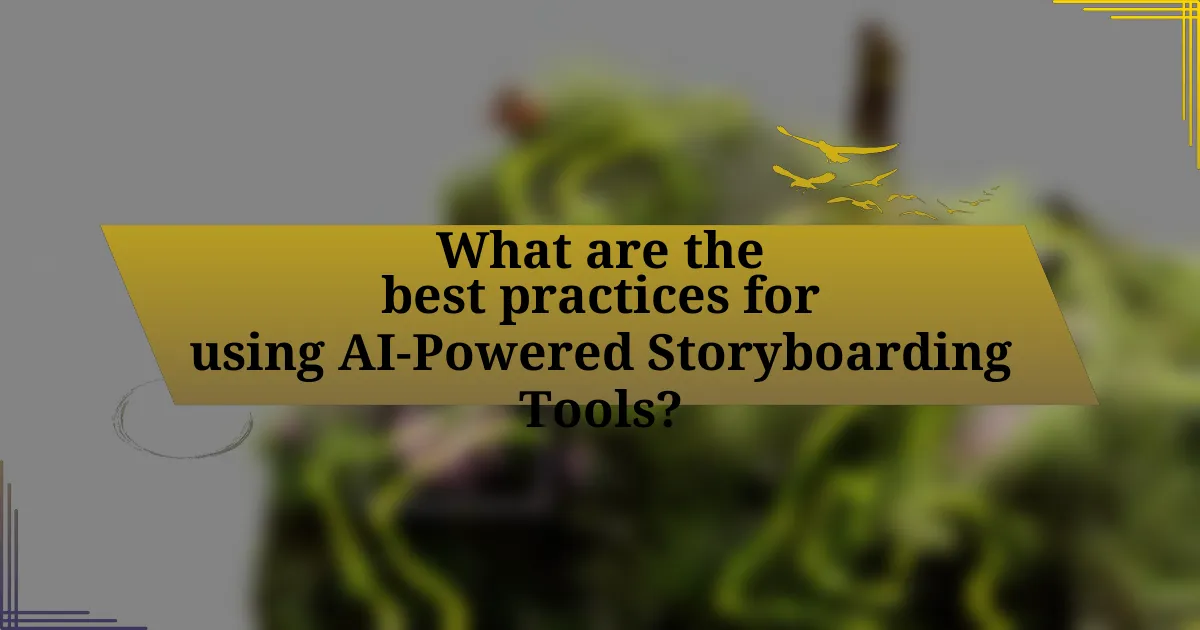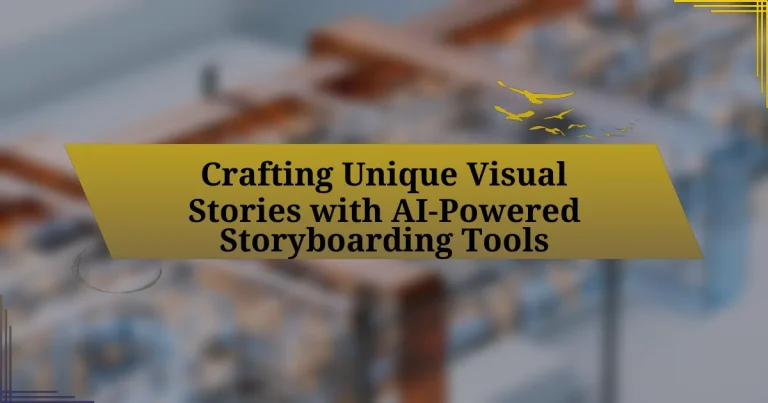AI-powered storyboarding tools are software applications that leverage artificial intelligence to assist creators in visualizing and organizing narratives. These tools automate tasks such as generating scene layouts and suggesting visual elements, enhancing creativity and efficiency in the storyboarding process. The article explores the functionality of these tools, the technologies that underpin them, and their impact on various storytelling mediums. It also addresses the importance of unique visual storytelling for audience engagement, the challenges creators face, and best practices for maximizing the potential of AI tools in crafting compelling visual narratives.

What are AI-Powered Storyboarding Tools?
AI-powered storyboarding tools are software applications that utilize artificial intelligence to assist creators in visualizing and organizing their narratives. These tools streamline the storyboarding process by automating tasks such as generating scene layouts, suggesting visual elements, and providing real-time feedback on narrative structure. For instance, tools like Storyboard That and Plotagon leverage AI algorithms to enhance creativity and efficiency, allowing users to focus more on storytelling rather than technical details.
How do AI-Powered Storyboarding Tools function?
AI-powered storyboarding tools function by utilizing machine learning algorithms to analyze scripts and generate visual representations of scenes. These tools process textual input, identifying key elements such as characters, settings, and actions, and then create corresponding images or layouts that illustrate the narrative flow. For instance, tools like Storyboard That and Canva leverage AI to suggest scene compositions and character placements based on the context provided, enhancing the creative process for users. This functionality is supported by advancements in natural language processing and computer vision, enabling the tools to produce coherent and visually appealing storyboards efficiently.
What technologies underpin AI-Powered Storyboarding Tools?
AI-powered storyboarding tools are primarily underpinned by machine learning, natural language processing, and computer vision technologies. Machine learning algorithms enable these tools to analyze and generate visual content based on user inputs, while natural language processing allows for the interpretation of scripts and dialogue to create corresponding visuals. Additionally, computer vision techniques facilitate the recognition and manipulation of images and video content, enhancing the overall storytelling experience. These technologies work together to streamline the creative process, making it more efficient and accessible for users.
How do these technologies enhance the storyboarding process?
AI-powered storyboarding tools enhance the storyboarding process by automating repetitive tasks and providing intelligent suggestions for visual elements. These technologies streamline the workflow, allowing creators to focus on narrative development rather than manual drawing or layout adjustments. For instance, AI can analyze scripts and generate visual representations, significantly reducing the time required to create storyboards. Additionally, tools equipped with machine learning algorithms can learn from user preferences, offering personalized recommendations that align with the creator’s style. This integration of AI not only increases efficiency but also fosters creativity by enabling rapid iteration and exploration of different visual concepts.
What types of visual stories can be crafted using these tools?
AI-powered storyboarding tools can craft various types of visual stories, including narrative-driven animations, interactive presentations, and marketing videos. These tools enable creators to visualize complex narratives through story arcs, character development, and scene transitions, enhancing storytelling effectiveness. For instance, narrative-driven animations can utilize AI to generate character designs and backgrounds, while interactive presentations can incorporate user engagement elements, such as clickable choices that influence the story’s direction. Marketing videos benefit from these tools by allowing for rapid prototyping and iteration, ensuring that visual content aligns with brand messaging and audience preferences.
How do different genres influence the storyboarding approach?
Different genres significantly influence the storyboarding approach by dictating the visual style, pacing, and thematic elements of the narrative. For instance, in horror genres, storyboards often emphasize suspenseful framing and dark color palettes to evoke fear, while action genres prioritize dynamic angles and rapid cuts to enhance excitement. Additionally, comedies may utilize exaggerated expressions and timing in their storyboards to maximize humor. These genre-specific techniques are essential for effectively conveying the intended emotional responses and narrative structures, as evidenced by the distinct visual storytelling methods employed in films like “Get Out” for horror and “Mad Max: Fury Road” for action.
What are the unique characteristics of visual storytelling in various mediums?
Visual storytelling in various mediums is characterized by the integration of visual elements, narrative structure, and audience engagement. In film, visual storytelling relies on cinematography, editing, and sound design to convey emotions and plot, as seen in the use of color grading to evoke specific feelings. In graphic novels, the combination of illustrations and text creates a unique pacing and rhythm, allowing readers to interpret the story through visual cues. In digital media, interactivity enhances storytelling by allowing users to influence the narrative flow, exemplified by video games where player choices shape outcomes. Each medium employs distinct techniques to enhance the storytelling experience, making visual storytelling a versatile and powerful form of communication.

Why is crafting unique visual stories important?
Crafting unique visual stories is important because it enhances engagement and retention among audiences. Unique visual narratives capture attention more effectively than traditional storytelling methods, leading to a deeper emotional connection with the content. Research indicates that visuals are processed 60,000 times faster than text, making them a powerful tool for communication. Furthermore, unique stories differentiate brands in a saturated market, fostering brand loyalty and recognition.
How does unique visual storytelling impact audience engagement?
Unique visual storytelling significantly enhances audience engagement by creating memorable and emotionally resonant experiences. This approach captures attention more effectively than traditional methods, as visuals can convey complex narratives quickly and clearly. Research indicates that visuals are processed 60,000 times faster than text, making them a powerful tool for communication. Furthermore, studies show that storytelling combined with visuals can increase retention rates by up to 65%, demonstrating that audiences are more likely to remember and connect with content that employs unique visual elements.
What psychological effects do visual stories have on viewers?
Visual stories significantly influence viewers’ emotions, cognition, and behavior. They evoke empathy by allowing viewers to connect with characters and narratives, which can lead to increased emotional engagement and understanding of diverse perspectives. Research indicates that visual storytelling activates brain regions associated with emotional processing, enhancing memory retention and recall. For instance, a study published in the journal “Cognitive Science” by Paul Zak found that narratives with emotional content can increase oxytocin levels, fostering feelings of trust and connection among viewers. This demonstrates that visual stories not only entertain but also shape viewers’ psychological states and social interactions.
How can unique visual stories differentiate a brand or message?
Unique visual stories can differentiate a brand or message by creating a distinct narrative that resonates emotionally with the audience. This differentiation occurs because visual storytelling engages viewers more effectively than traditional text-based communication, leading to higher retention rates and brand recall. Research indicates that visuals are processed 60,000 times faster than text, making them a powerful tool for conveying complex ideas succinctly. Furthermore, brands that utilize unique visual stories can establish a stronger identity, as seen in case studies where companies like Apple and Nike have successfully used compelling visuals to communicate their values and connect with consumers on a deeper level.
What challenges do creators face in crafting unique visual stories?
Creators face several challenges in crafting unique visual stories, including originality, audience engagement, and technical limitations. Originality is crucial as creators must differentiate their work in a saturated market, where many ideas may overlap. Audience engagement is another challenge, as creators need to connect emotionally with viewers while conveying their narrative effectively. Technical limitations, such as software constraints or lack of resources, can hinder the creative process, making it difficult to realize their vision fully. These challenges are compounded by the rapid evolution of technology, which requires creators to continuously adapt and learn new tools to stay relevant.
How can AI tools help overcome these challenges?
AI tools can help overcome challenges in crafting unique visual stories by automating the storyboarding process, enhancing creativity, and providing data-driven insights. These tools streamline the creation of storyboards by generating visual elements based on narrative input, allowing creators to focus on storytelling rather than technical details. For instance, AI algorithms can analyze existing visual narratives to suggest innovative compositions and styles, thereby expanding creative possibilities. Additionally, AI can assess audience preferences through data analysis, enabling storytellers to tailor their content more effectively. This combination of automation, creativity enhancement, and audience insight demonstrates the significant role AI tools play in overcoming challenges in visual storytelling.
What common pitfalls should creators avoid when using AI tools?
Creators should avoid over-reliance on AI tools, as this can lead to a lack of originality and creativity in their work. When creators depend too heavily on AI-generated content, they risk producing generic or formulaic outputs that do not reflect their unique voice or vision. Additionally, creators should be cautious of the limitations of AI, such as its inability to fully understand context or emotional nuance, which can result in misinterpretations or inappropriate content. Furthermore, failing to critically evaluate AI-generated suggestions can lead to the incorporation of inaccuracies or biases present in the training data of the AI. Lastly, neglecting to maintain a balance between AI assistance and personal input can diminish the authenticity of the storytelling process.

What are the best practices for using AI-Powered Storyboarding Tools?
The best practices for using AI-powered storyboarding tools include defining clear objectives, utilizing templates, and iterating based on feedback. Clear objectives guide the AI in generating relevant content, ensuring that the storyboard aligns with the intended narrative. Utilizing templates can streamline the process, allowing users to focus on creativity rather than formatting. Iterating based on feedback helps refine the storyboard, enhancing its effectiveness and coherence. These practices are supported by user experiences that demonstrate improved efficiency and creativity when following structured approaches in AI-assisted projects.
How can creators maximize the potential of these tools?
Creators can maximize the potential of AI-powered storyboarding tools by leveraging their features for enhanced creativity and efficiency. By utilizing automated scene generation, creators can quickly visualize concepts, allowing for rapid iteration and refinement of ideas. Additionally, integrating user feedback mechanisms within these tools can help creators tailor their narratives to audience preferences, ensuring greater engagement. Research indicates that tools that facilitate collaboration and real-time editing significantly improve the creative process, as seen in studies highlighting increased productivity among teams using such technologies.
What strategies can enhance collaboration among team members?
Effective strategies to enhance collaboration among team members include establishing clear communication channels, utilizing collaborative tools, and fostering a culture of trust and respect. Clear communication channels, such as regular meetings and dedicated messaging platforms, ensure that all team members are aligned on goals and expectations. Collaborative tools, like shared documents and project management software, facilitate real-time collaboration and streamline workflows. Fostering a culture of trust and respect encourages open dialogue and the sharing of ideas, which is essential for creative processes, particularly in crafting unique visual stories with AI-powered storyboarding tools. Research indicates that teams with high levels of trust are 50% more productive, highlighting the importance of these strategies in enhancing collaboration.
How can feedback loops improve the storyboarding process?
Feedback loops can significantly enhance the storyboarding process by facilitating continuous improvement and refinement of ideas. By incorporating regular input from team members and stakeholders, creators can identify strengths and weaknesses in their storyboards early on, allowing for timely adjustments. Research indicates that iterative feedback mechanisms lead to higher-quality outcomes, as they encourage collaboration and diverse perspectives, ultimately resulting in a more cohesive and engaging visual narrative.
What resources are available for learning about AI-Powered Storyboarding?
Resources for learning about AI-Powered Storyboarding include online courses, tutorials, and specialized software documentation. Platforms like Coursera and Udemy offer courses specifically focused on AI in creative processes, including storyboarding. Additionally, websites such as Medium and Towards Data Science feature articles and case studies that explore the integration of AI in visual storytelling. Software tools like Storyboard That and Canva provide user guides and community forums that can enhance understanding of AI-powered features. These resources collectively support the learning process by providing structured education, practical examples, and community engagement.
Which online courses or tutorials are recommended for beginners?
For beginners interested in crafting unique visual stories with AI-powered storyboarding tools, recommended online courses include “Storyboarding for Animation” on Udemy and “Introduction to Storyboarding” on LinkedIn Learning. These courses provide foundational knowledge in storyboarding techniques and the use of AI tools, making them suitable for novices. Both platforms have received positive reviews, with Udemy reporting over 10,000 enrollments in its storyboarding course, indicating a strong demand and effectiveness in teaching the subject.
What communities or forums can provide support and insights?
Communities and forums that provide support and insights for crafting unique visual stories with AI-powered storyboarding tools include Reddit’s r/Filmmakers, where users share experiences and tips related to filmmaking and storyboarding. Additionally, the Creative COW forum offers discussions on various aspects of video production, including storyboarding techniques and tools. These platforms facilitate knowledge exchange among creators, enhancing understanding and application of AI in visual storytelling.
What tips can help creators effectively use AI-Powered Storyboarding Tools?
Creators can effectively use AI-Powered Storyboarding Tools by leveraging their features for enhanced visualization and organization of ideas. Utilizing templates provided by these tools can streamline the storyboarding process, allowing creators to focus on narrative development rather than formatting. Additionally, integrating AI-generated suggestions can inspire creativity and provide fresh perspectives on story elements. Regularly updating and refining storyboards based on feedback can also enhance the overall quality of the visual narrative. These practices are supported by the increasing adoption of AI in creative industries, which has shown to improve efficiency and innovation in storytelling.

